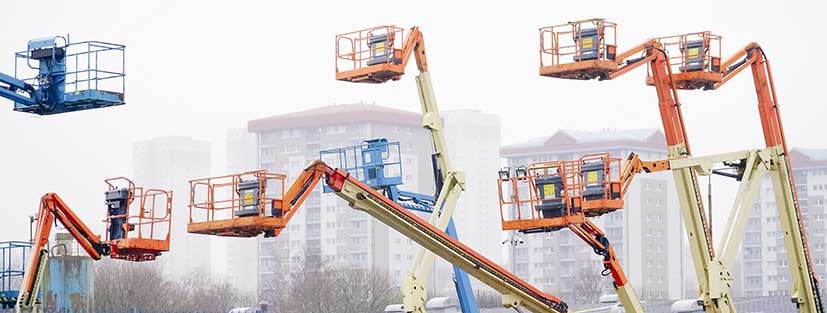What is the law around MEWP pre-use safety inspection legislation?
 MEWP safety falls under three main sets of legislation – The Work at Height Regulations 2005, The Provision and Use of Work Equipment Regulations 1998 (PUWER), The Lifting Operations and Lifting Equipment Regulations 1998 (LOLER). Additionally, there is useful supporting guidance from the HSE and the International Powered Access Federation (IPAF).
MEWP safety falls under three main sets of legislation – The Work at Height Regulations 2005, The Provision and Use of Work Equipment Regulations 1998 (PUWER), The Lifting Operations and Lifting Equipment Regulations 1998 (LOLER). Additionally, there is useful supporting guidance from the HSE and the International Powered Access Federation (IPAF).
What the law requires
The Work at Height Regulations 2005 require an assessment to be carried out before starting any work at height. If the assessment determines that the work can be carried out in a way that avoids having someone working at height then this must be done. However, if the assessment confirms that there is no alternative to working at height then the work must be properly planned and organised in advance by a competent person to ensure that the most suitable work equipment is chosen.
When choosing the most suitable work equipment, you must follow the fall protection hierarchy. This states the order in which protective measures should be considered to prevent and mitigate the risks when working at height cannot be avoided.
The Provision and Use of Work Equipment Regulations 1998 (PUWER) require the risks from using equipment at work to be prevented or controlled and specifically focuses on minimising the overturning risks associated with mobile work equipment such as MEWPs. This is particularly relevant when considering the ground, environmental and operating conditions that the MEWP may experience.
The Lifting Operations and Lifting Equipment Regulations 1998 (LOLER) require that all lifting operations are planned by a competent person and that any equipment used for lifting or lowering loads or people (including MEWPs) should be of adequate strength and stability and thoroughly examined at regular intervals thereafter.
Inspection, maintenance and examination
The HSE recommends that a programme of daily visual checks, regular inspections and servicing schedules should be established in accordance with the manufacturer’s instructions and the risks associated with each MEWP. This guidance covers all types of MEWPS including vertical ‘scissor’ lifts, self-propelled booms, vehicle-mounted booms and trailer-mounted boom.
Operators should be encouraged to report defects or problems. Reported problems should be put right quickly and the MEWP taken out of service if the item is safety critical.
The MEWP must be thoroughly examined at least every six months by a competent person or in accordance with an examination scheme drawn up by such a competent person.
HSE GEIS6 The selection, management and use of mobile elevating work platforms
The Thorough Examination and the Pre-Use Check.
A thorough examination is a systematic and detailed examination of the lifting equipment by a competent person to detect any defects that are, or might become, dangerous. It must be carried out every six months by a competent person, or at an increased frequency in accordance with an examination scheme drawn up by such a competent person. You should ask to see and retain the report of the thorough examination for any MEWP equipment you are going to allow to be used on your site.
The MEWP operator is responsible for carrying out a basic daily/pre-use function check. A pre-start inspection should be a habit carried out every day and all staff should be briefed on what they entail. These checks will confirm that the machinery is safe to operate and identify any potential hazards it may pose before the work at height is carried out. Records of these checks should be kept. The operator should also be fully aware of the procedure their employer expects them to follow should they identify a fault with the MEWP, eg isolate the controls, tag the machine and report the defect to the person in control.
There are a number of key functions and features on access platforms which should be in full working order before the equipment is used. Even if the access equipment is rented from a reputable firm, the hirer is responsible for the health and safety of the people using it, so it is important to carry out your own checks as well as those done by the supplier.
Checks usually include visual and function checks covering areas such as:
Controls – Test all lift controls before any people or equipment are raised from the ground. This should include cut out switches and emergency stop mechanisms.
Hydraulic fluid and petrol – The oil level in the tank should be full when the platform is on a level surface and there should be enough fuel in the tank to complete the job.
Maintenance – Check the vehicle for any signs of damage or age which might cause it to malfunction. This should include identifying damaged or loose hoses or fittings, rust, corrosion, holes and electrical faults.
Stability – For a mobile access platform, the brakes of the vehicle should be fully functional. The base of a powered access platform needs to be locked into position before the platform is extended or elevated. Check all stabiliser legs and extendable parts are operational before use.
MEWPS have become an essential choice of equipment for short term work at height activities. They are a simple way to access high places, mobile for easy positioning and can actually increase the job speed and efficiency. However, they are held to high safety standards including a robust inspection regime.
About Lisa Robinson
Lisa - word smith to the gods.

